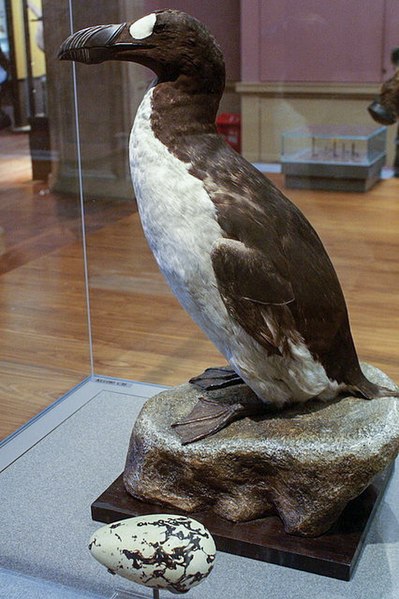Ficheru:Great Auk (Pinguinis impennis) specimen, Kelvingrove, Glasgow - geograph.org.uk - 1108249.jpg

Tamañu d'esta previsualización: 399 × 599 pixels. Otres resoluciones: 160 × 240 pixels | 426 × 640 pixels.
Ficheru orixinal (426 × 640 píxels, tamañu de ficheru: 271 kB, triba MIME: image/jpeg)
Historial del ficheru
Calca nuna fecha/hora pa ver el ficheru como taba daquella.
| Data/Hora | Miniatura | Dimensiones | Usuariu | Comentariu | |
|---|---|---|---|---|---|
| actual | 09:26 11 ago 2017 |  | 426 × 640 (271 kB) | Archaeodontosaurus | Corrections |
| 17:46 24 feb 2011 |  | 426 × 640 (78 kB) | GeographBot | == {{int:filedesc}} == {{Information |description={{en|1=Great Auk (Pinguinis impennis) specimen, Kelvingrove, Glasgow A lost part of the biogeography of Britain, and the only flightless bird that has bred in Europe in historical times. The last Great Auk |
Usu del ficheru
La páxina siguiente usa esti ficheru:
Usu global del ficheru
Estes otres wikis usen esti ficheru:
- Usu en ar.wikipedia.org
- Usu en arz.wikipedia.org
- Usu en as.wikipedia.org
- Usu en az.wikipedia.org
- Usu en bg.wikipedia.org
- Usu en bn.wikibooks.org
- Usu en ca.wikipedia.org
- Usu en da.wikipedia.org
- Usu en de.wikipedia.org
- Usu en en.wikipedia.org
- Usu en en.wikibooks.org
- Usu en en.wiktionary.org
- Usu en es.wikipedia.org
- Usu en et.wikipedia.org
- Usu en eu.wikipedia.org
- Usu en fa.wikipedia.org
- Usu en fi.wiktionary.org
- Usu en fo.wikipedia.org
- Usu en fr.wikipedia.org
- Usu en fy.wikipedia.org
- Usu en ga.wikipedia.org
- Usu en gd.wikipedia.org
- Usu en gl.wikipedia.org
- Usu en he.wikipedia.org
- Usu en ia.wikipedia.org
- Usu en it.wikipedia.org
- Usu en ja.wiktionary.org
- Usu en jv.wikipedia.org
- Usu en la.wikipedia.org
- Usu en lv.wikipedia.org
- Usu en ml.wikipedia.org
- Usu en mrj.wikipedia.org
- Usu en no.wikipedia.org
Ver más usos globales d'esti ficheru.

